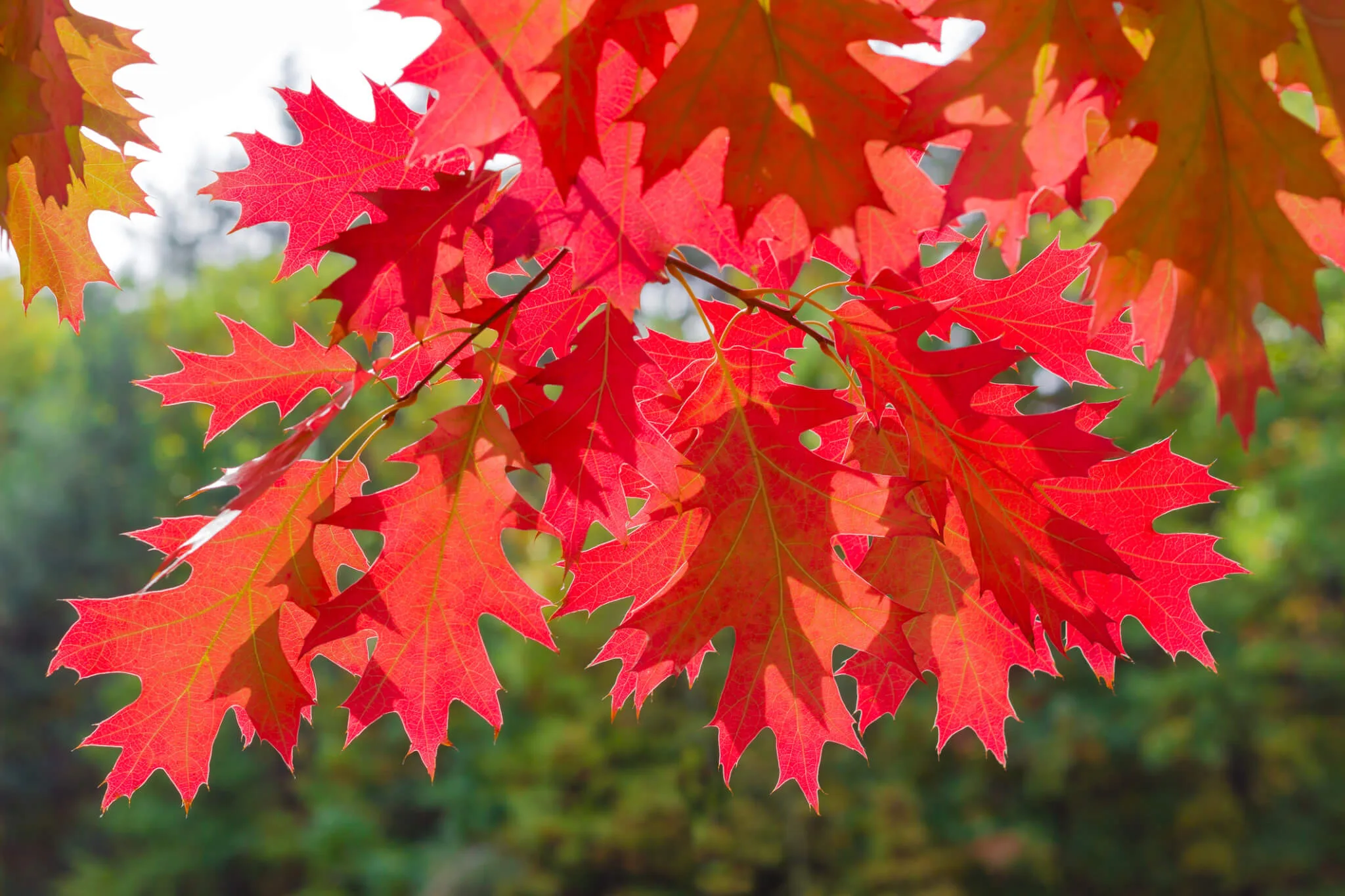
Branches of red oak with red leaves hanging from the top on blurred green background of the forest by iStock / Getty Images
“Once oak wilt gets started, it is expensive to successfully manage and will kill all nearby red oaks over time, if untreated,” said James Wieferich, forest health specialist in the DNR’s Forest Resources Division.
Need to Know
- During this time of year, oak trees are at high risk for a fungal infection called oak wilt that can kill red oak trees and weaken white oak trees.
- To minimize the risk of oak wilt infection, the DNR restricts cutting of red oak trees on state land between April 15 and July 15.
- If your oak tree gets damaged from pruning, immediately cover all wounds with tree-wound paint or latex-based paint.
MICHIGAN—As the season arrives for Michiganders to be working in their yards, trimming back those big oak trees should come off of everyone’s outdoor to-do list.
The Department of Natural Resources (DNR) recently warned that oak trees are at high risk for oak wilt infection, particularly from April 15 to July 15. Oak wilt is a serious fungal disease that can weaken white oaks and kill red oak trees within a few weeks. Flying beetles can spread fungus from tree to tree during this time of the year, and the fungus can then enter through wounds from pruning or storm damage.
“The guidelines against pruning oak trees during this time are designed to help prevent the spread of this tree-killing disease to new areas,” said James Wieferich, forest health specialist in DNR’s Forest Resources Division. “Once oak wilt gets started, it is expensive to successfully manage and will kill all nearby red oaks over time, if untreated.”
If you have an oak tree that gets damaged during this high-risk time, the DNR advises to immediately cover all wounds with tree-wound paint or latex-based paint. However, painting tree wounds for other tree species is not recommended, as it can reduce the effectiveness of the healing process.
The fungus can move through the root grafts to neighboring oaks up to 100 feet away. If left untreated, oak wilt will continue to move from tree to tree, killing more red oaks over an increasingly larger area. As more trees die from oak wilt, more fungal spores are produced, which allows the beetle to carry infection to new locations.
For many Michiganders, oaks are their favorite trees. Of the 600 oaks species worldwide, 10 are native to Michigan, according to inventory data from the U.S. Department of Agriculture’s Forest Service. Michigan’s species of oak are divided into two subgroups — red oaks and white oaks.
Red oaks have pointed leaf lobes with acorns that germinate in spring, and include black oak, northern red oak and northern pin oak. Meanwhile, white oaks have rounded or blunt leaf lobes with acorns germinating soon after falling. White oak varieties include swamp white oak and bur oak.
Oak wilt was first identified in the 1940s and is now widespread across Michigan. Red oaks are most susceptible to the disease. Symptoms usually appear from late June until September, where the affected trees wilt from top-down, rapidly dropping leaves that can be green or brown, or a combination of both colors.
The DNR also cautioned against transporting firewood cut from an infected tree as it can still carry the fungus.
“If you suspect your firewood is infected by oak wilt, you can help slow the spread by burning it, chipping it or debarking it before April,” the DNR stated in a release. “Once the firewood has been dried for longer than a year and/or all the bark loosens, the firewood can no longer spread oak wilt.”
To minimize the risk of oak wilt infection caused by logging damage, the DNR restricts cutting of red oak trees on state land between April 15 and July 15. Private forest landowners are urged to use caution during this period and delay activity in oak forests until after July 15.
READ MORE: Young Michiganders Want Politicians to Prioritize Wildlife Recovery

VIDEO: Trump isn’t the only republican facing charges for alleged financial crimes
https://www.tiktok.com/@gandernewsroom/video/7361494909938978090 A whole lot of Michigan Republicans and lobbyists are facing criminal charges for...

VIDEO: It’s expensive to be poor in Michigan
https://www.tiktok.com/@gandernewsroom/video/7361154790300060974 Ever heard of predatory payday loans? Here’s how new laws could help protect...

Here’s everything you need to know about this month’s Mercury retrograde
Does everything in your life feel a little more chaotic than usual? Or do you feel like misunderstandings are cropping up more frequently than they...

The ’Gander wins multiple 2023 Michigan Press Association awards
MICHIGAN—The ’Gander Newsroom has earned multiple awards in the 2023 Michigan Press Association Better Newspaper Contest. The awards were announced...

Michigan Republicans ask Supreme Court to restrict medication abortion access
A lawsuit supported by Republicans could disrupt access to the most common form of abortion—even in Michigan, where reproductive rights are...





